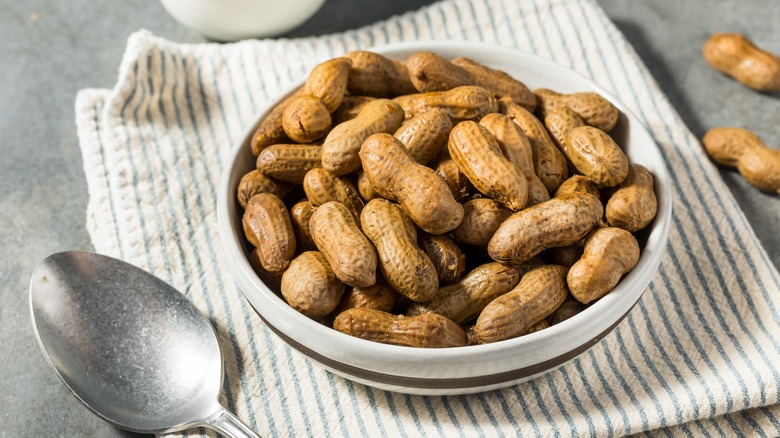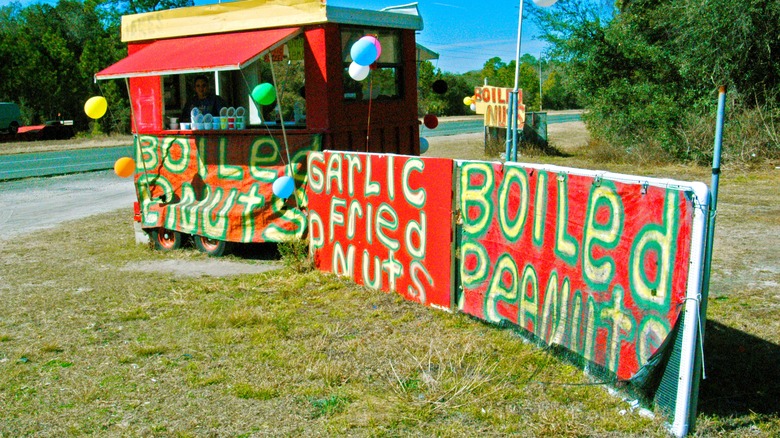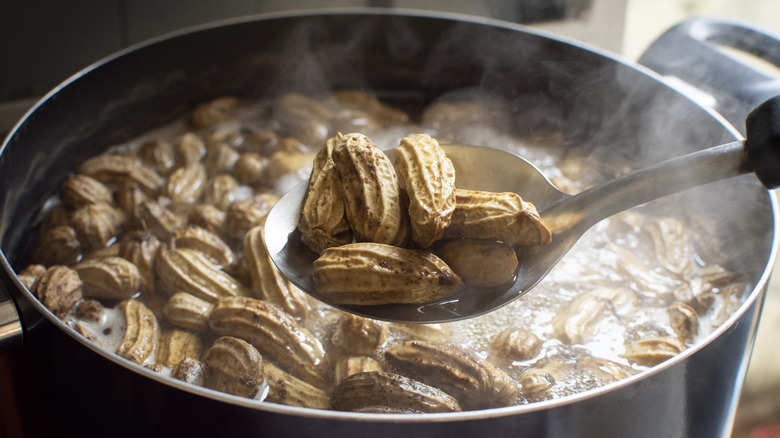How Boiled Peanuts Became A Classic Southern Delicacy
It's safe to say many of us have enjoyed America's favorite legume roasted, salted, or made into peanut butter. However, if you weren't raised in the South, you may have never heard of eating peanuts boiled. Southerners have enjoyed boiled peanuts for centuries, but the history of this snack has somber origins. Many don't know that the tradition of boiling peanuts began long ago and far away from the peanut fields of South Carolina where this local delicacy has been the state's official snack since 2006.
Like many foods enjoyed today, such as yams, okra, collards, and eggplant, peanuts appeared in North America when enslaved persons were first brought to its shores from Africa. While peanuts were originally introduced to the continent by traders from Brazil, they had become a staple for West African people by the time the first slave ships arrived. Enslavers who were unfamiliar with the diets of their captives loaded their ships with foods from the home countries of those they captured and enslaved against their will. The story of the boiled peanut only grows from there.
Southern boiled peanuts were born out of necessity
Food rations given to enslaved people were often insufficient to fuel them through the long days of labor in the fields, so many supplemented their diets by planting small gardens or "patches." These patches contained plants typically grown in North America but also plants native to their home. This allowed them to preserve what they could of their culture and heritage while adding to the meager diet of themselves and their families.
In his book "An Irresistible History of Southern Food," author Rick McDaniel cites a former research staffer from Colonial Williamsburg as saying that archeological evidence proves that peanuts were just one of the crops grown in the small plots of land used by the enslaved. Other crops include collards, onions, and pole beans. Often, the rations provided didn't include vegetables, making the patches essential for nutrition.
Since the 18th century, people have gathered at "peanut boils" to cook large amounts of peanuts. However, peanut boils weren't just a way to cook the beans; they were also a social event and an opportunity to strengthen friendships and bonds. These events continue today in some parts of the South, including Crenshaw County, Alabama, which boasts the World's Largest Peanut Boil. But this dish isn't strictly for events — they can be found at roadside stands, sold from the backs of pickup trucks, and in gas stations all over the South.
What to know about making boiled peanuts at home
If you want to try boiled peanuts for yourself, they're easy to make at home. Only use raw peanuts, as the roasting process changes the flavor entirely. Raw peanuts for boiled peanuts come in two forms: freshly harvested green peanuts and dried raw peanuts. Either of them will work.
Preparing boiled peanuts is a simple but technically involves a lengthy process that can take a couple of hours. The water used to boil them can be seasoned with your favorite spices to enhance and customize the flavor based on your personal tastes. Lots of salt is critical, but you can try adding Old Bay, cayenne pepper, or smoked paprika to the water to season the peanuts. Onions and jalapeños add a unique flavor, and potlikker — the broth left over from cooking collards — can bring your boiled peanuts to a new level.
The National Peanut Board advises against eating the chewy and tough shell. A true Southerner knows the best way to eat a boiled peanut, by breaking the shell lengthwise and then sucking it out of its casing. This allows you to enjoy the salty and flavorful liquid it acquires during the cooking process. And remember: If you find yourself traveling in the Southeastern part of the United States, keep an eye out for boiled peanuts. It's worth a stop to try this iconic treat with a long history.


